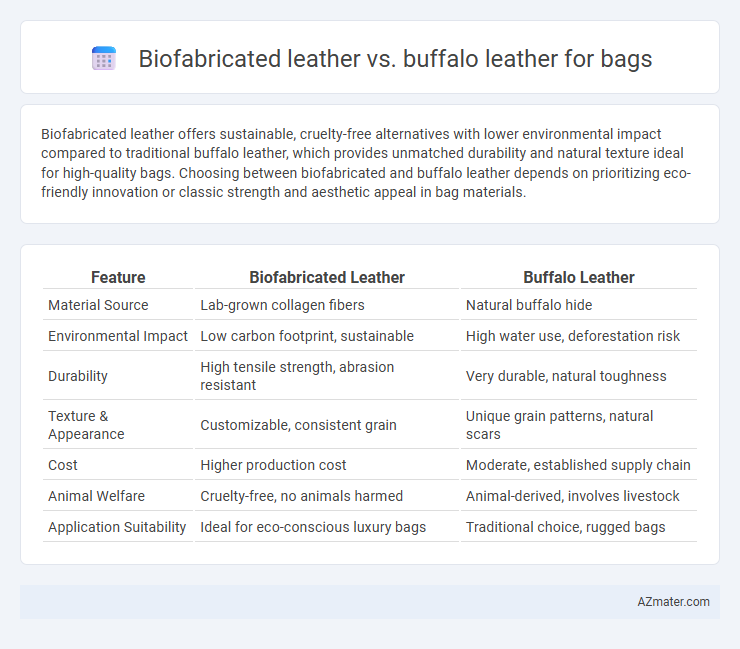Biofabricated leather offers sustainable, cruelty-free alternatives with lower environmental impact compared to traditional buffalo leather, which provides unmatched durability and natural texture ideal for high-quality bags. Choosing between biofabricated and buffalo leather depends on prioritizing eco-friendly innovation or classic strength and aesthetic appeal in bag materials.
Table of Comparison
| Feature | Biofabricated Leather | Buffalo Leather |
|---|---|---|
| Material Source | Lab-grown collagen fibers | Natural buffalo hide |
| Environmental Impact | Low carbon footprint, sustainable | High water use, deforestation risk |
| Durability | High tensile strength, abrasion resistant | Very durable, natural toughness |
| Texture & Appearance | Customizable, consistent grain | Unique grain patterns, natural scars |
| Cost | Higher production cost | Moderate, established supply chain |
| Animal Welfare | Cruelty-free, no animals harmed | Animal-derived, involves livestock |
| Application Suitability | Ideal for eco-conscious luxury bags | Traditional choice, rugged bags |
Overview of Biofabricated Leather and Buffalo Leather
Biofabricated leather is an innovative, sustainable material produced through cellular agriculture, replicating traditional leather's texture without animal farming, reducing environmental impact significantly. Buffalo leather, sourced from the hides of water buffalo, is praised for its durability, natural grain, and resistance to wear, commonly used in luxury bags for its robust quality. When comparing biofabricated and buffalo leather, biofabricated options offer eco-friendly alternatives with customizable properties, whereas buffalo leather provides classic toughness and heritage appeal.
Raw Material Sources and Sustainability
Biofabricated leather derives from cultured collagen produced in laboratories, using yeast or bacteria fermentation, eliminating the need for animal farming and reducing environmental strain. Buffalo leather originates from water buffalo hides, a byproduct of livestock agriculture, often linked to land degradation, water consumption, and methane emissions. Biofabricated leather's closed-loop production significantly lowers carbon footprint and water usage, making it a more sustainable alternative to the resource-intensive traditional buffalo leather industry in bag manufacturing.
Production Processes: Traditional vs Modern Techniques
Biofabricated leather for bags is created through modern techniques involving the cultivation of animal cells in a lab, eliminating the need for animal farming and reducing environmental impact. Buffalo leather relies on traditional tanning processes that involve animal hides, extensive water use, and chemical treatments to create durable, natural materials. The shift from conventional tanning to biofabrication reflects innovation in sustainable production methods, offering alternatives with potentially lower carbon footprints and resource consumption.
Environmental Impact Comparison
Biofabricated leather significantly reduces environmental impact compared to traditional buffalo leather by minimizing water consumption, greenhouse gas emissions, and land use. Buffalo leather production involves intensive livestock farming, leading to high methane output and deforestation, whereas biofabricated leather relies on sustainable cell culture techniques with a smaller carbon footprint. Choosing biofabricated leather for bags supports more eco-friendly manufacturing practices and resource conservation.
Durability and Longevity
Biofabricated leather offers enhanced durability through its engineered structure, resisting wear and tear better than traditional buffalo leather in many cases. Buffalo leather, known for its toughness and natural fiber density, provides exceptional longevity, especially with proper care and conditioning. Bags made from biofabricated leather showcase improved resistance to environmental factors like moisture and UV rays, extending their lifespan compared to conventional buffalo leather.
Aesthetic Qualities and Customization Options
Biofabricated leather offers a consistent texture and color palette, providing sleek, uniform aesthetics ideal for modern and minimalist bag designs. Buffalo leather features natural grain patterns and tonal variations, delivering a rich, authentic appearance prized for rustic and vintage-style bags. Customization in biofabricated leather includes precise color matching and embossing options due to its controlled production process, while buffalo leather allows for unique patinas and personalized finishes that enhance character over time.
Cost Analysis and Market Trends
Biofabricated leather commands a higher initial cost compared to traditional buffalo leather due to advanced manufacturing processes and sustainability credentials. Market trends indicate increasing consumer demand for eco-friendly materials, driving investments and price adjustments in biofabricated leather products. Buffalo leather remains competitively priced with established supply chains, but faces fluctuating costs linked to livestock industry dynamics and environmental regulations.
Performance in Bag Manufacturing
Biofabricated leather offers enhanced durability and water resistance compared to traditional buffalo leather, making it highly suitable for bag manufacturing. Its uniform texture and consistent thickness improve cutting precision and reduce material waste during production. Buffalo leather provides natural strength and a unique grain pattern, valued for aesthetic appeal but may require additional treatment to match the performance stability of biofabricated alternatives.
Ethical and Animal Welfare Considerations
Biofabricated leather offers an ethical alternative to traditional buffalo leather by eliminating the need for animal slaughter, significantly reducing animal suffering and promoting sustainable production practices. Buffalo leather involves raising and slaughtering animals, which raises concerns about animal welfare, environmental impact, and resource consumption. Choosing biofabricated leather supports cruelty-free fashion and aligns with growing consumer demand for sustainable and responsible material sourcing in bag manufacturing.
Future Prospects in the Bag Industry
Biofabricated leather offers a sustainable and cruelty-free alternative to traditional buffalo leather, reducing environmental impact by minimizing land use, water consumption, and greenhouse gas emissions. Innovations in biofabrication technology are enhancing material durability, texture, and cost-effectiveness, positioning it as a competitive option for high-end and mass-market bag production. The growing consumer demand for eco-friendly products is likely to drive widespread adoption of biofabricated leather, potentially reshaping the bag industry's supply chains and manufacturing processes in the near future.

Infographic: Biofabricated leather vs Buffalo leather for Bag
 azmater.com
azmater.com